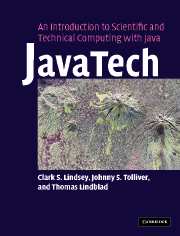Book contents
23 - Accessing the platform
Published online by Cambridge University Press: 08 January 2010
Summary
Escaping the sandbox
The Java Virtual Machine (JVM) is often said to provide a safe and self-contained sandbox where programs such as applets can play without accidentally or deliberately entering restricted areas of the platform. That is sufficient if all a program does is interact with the user via a graphical interface but many programs need to reach out and access the world beyond the JVM to obtain information and interact with external hardware.
In Chapter 22 we showed how Java classes can link to native codes, which possess none of Java's security restrictions. This is the ultimate form of local platform access but it involves a lot of inelegant coding and violates the portability of Java. In this chapter we look at less drastic ways that a program can access the platform. We first show how a program can obtain properties describing the platform such as the operating system, the Java version, and screen size. We then explain how to run a non-Java program from within a Java program. Next we discuss how to use serial ports to communicate with external devices. We include a demonstration program in which a Java application communicates via a serial port with a temperature sensor.
We note that the security restrictions put into place by a browser JVM place severe limits on the access that applets have to the platform and the network. However, as we saw in Chapter 14, the security restrictions on Java applications can be easily customized as needed.
- Type
- Chapter
- Information
- Publisher: Cambridge University PressPrint publication year: 2005



